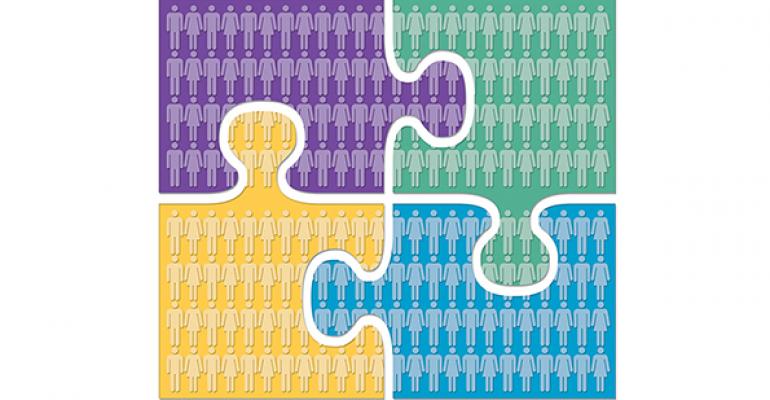The majority of U.S. restaurant chains are missing a vital chance to give their customers a good impression about the diversity and values of their companies at the place where many people look for them first: the Web.
That is the conclusion of a restaurant website study conducted by Mustang Consulting, a student-run consulting firm at Southern Methodist University, and commissioned by the Multicultural Foodservice and Hospitality Alliance.
The study evaluated the websites of the 100 largest restaurant chains, based on the NRN Top 100, and arrived at a sliding scale of letter grades — with “A” the highest ranking and “F” the lowest — for each one based on their depictions of diversity.
An “A” grade means an organization is committed to diversity through all of its public and internal communication and at least 50 percent of all website images reflect diversity, while an “F” grade means an organization has very little or no demonstrated diversity.
The study found that 85 percent of the sites analyzed received grades of “D” or “F” for their depictions of organizational diversity.
The restaurant industry does have a diverse workforce among hourly front-line workers in the U.S., according to the 2014 People Report-Multicultural Foodservice and Hospitality Alliance report, but the findings from People Report-MFHA indicate a major drop in diversity among store level managers and even more contrast among corporate-level managers and executives. That leaves the industry vulnerable to issues around equal employment and advancement opportunities. In cases where company executives do have diverse talent in senior roles, that diversity should be reflected not just in the boardroom but on its websites and marketing materials as well. Right now, that reflection is the exception rather than the rule, according to Mustang Consulting's research.
Maria Dixon Hall, associate professor of communications studies at Southern Methodist University, said it is a missed opportunity for chains to demonstrate the diversity of their organizations and build customer loyalty.
“They are leaving what we call client goodwill on the table,” Hall said. “This is the social media age. Millennials want to know who they’re purchasing from, what they stand for, and whether this is a business they want to be in partnership with.”
In addition, 8 percent of the websites had a dedicated hyperlink for diversity; only 11 percent had a multi-language option; and 20 percent have an explicit statement affirming the role of diversity in the company’s culture. A mere 3 percent of the 100 companies examined scored “A” grades in the study. All chains are ranked in aggregate only as part of NRN's exclusivity agreement with MFHA.
A mere 3 percent of the 100 companies examined scored “A” grades in the study. All chains are ranked in aggregate only as part of NRN's exclusivity agreement with MFHA.
“One of the biggest mistakes restaurants make is they believe they’re selling food. What they’re selling is a dining experience,” Hall said. “You’ve got to make me feel like I’m going to be in a safe atmosphere to enjoy my food.”
The study noted that the top-performing companies that received an “A” have a higher percentage of digital images showing people of different ethnicities working together. Those organizations also showed executive leadership that included at least 10 percent of people of color. And the companies have more visible statements advocating a commitment to an inclusive workforce compared with those who scored poorly.
A “B” grade – doled out to 5 percent of the organizations analyzed – signifies that diversity is an ingrained element of day-to-day operations and that at least 30 percent of all website images reflect diversity. Eight percent of organizations were given a “C” grade, which means that a company recognizes diversity is an important element in public branding, but its practices and values reflect overall ambivalence to actively seeking diversity. For these companies, at least 10 percent of images reflect diversity.
Those organizations receiving a grade “D” — almost half of those measured (47 percent) — demonstrated a weak commitment to diversity on their websites. Such organizations understand diversity as a legal mandate, and usually demonstrate commitment to diversity in legal boilerplate language, MFHA said. However, only 5 percent of total images on these organizations’ websites reflect diversity.
Thirty-eight percent of organizations received an “F” grade. These companies demonstrated little to no interest in diversity visually with less that 5 percent of total images reflecting diversity and no boilerplate language regarding anti-discrimination on the basis of race, gender, sexual orientation or ethnicity, according to MFHA.
“What these restaurants [that scored poorly] aren’t doing is showing that I’m going to find a person like myself at their restaurant,” Hall said. “I’m not going to find someone in the back kitchen who looks like me. I may not find a manager who looks like me. If they’re not welcoming me with people who look like me, how seriously am I going to take it that you’re going to extend an invitation to me to dine?”
She also noted that inclusive websites actually help in crisis management. If a chain is accused of racism, for instance, the website is often the first place people go when they hear of it. An inclusive website can offset that perception, but a non-inclusive site can put the chain in a “terrible position.”
Hall suggested that the websites aren’t necessarily reflections of the organizations themselves. She is African American and said her own father worked in the restaurant industry for 35 years. She said she understands the opportunity the industry often affords people of color.
“I have known the hospitality and the food industry offers opportunities, particularly for African American men and women, who come in through the back door and end up leaving through the front door,” she said. “These restaurants have some of the best advertising firms in the world working for them, but they’ve chosen not to highlight their heart. That’s disappointing to me.”
Contact Jonathan Maze at [email protected].
Follow him on Twitter: @jonathanmaze




